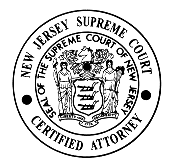Supreme Court of New Jersey
It has the sole authority to prescribe and amend court rules and regulate the practice of law, and it is the arbiter and overseer of the decennial legislative redistricting.[5] As time progressed and political philosophies changed, people took issue with numerous parts of the original constitution: It was hastily thrown together, used property qualifications for enfranchisement, contained scant guarantees of freedoms, was unamendable, and freely intermingled the three branches of government.[11] If the Commission still cannot reach a 7–6 majority in favor of a final redistricting configuration, the two district plans receiving the greatest number of votes, but not fewer than five votes, are submitted to the Supreme Court, which selects and certifies whichever of the two plans so submitted conforms most closely to the requirements of the Constitution and laws of the United States.By virtue of accepting a position in the Executive or Legislative branches of government or becoming a candidate for political office, a justice is considered as resigned from the bench.[22] By tradition, a partisan balance is maintained on the Supreme Court, with the sitting governor permitted to arrange his appointments so that his party has a one-seat advantage.When Zazzali reached the age of 70 less than a year later, Corzine was able to nominate a Democrat, Attorney General and former federal prosecutor Stuart Rabner, to serve as chief justice.After New Jersey Senate Majority Leader Stephen Sweeney, a Democrat, refused to consider any nominee to Wallace's seat, Christie nominated Patterson to replace Justice Rivera-Soto who announced he would step down when his term expired in September 2011.[27] On June 5, 2020, Murphy announced his intention to nominate Fabiana Pierre-Louis to replace Justice Walter F. Timpone, who was required to retire on November 10, 2020.[36] A week later, Murphy announced his intention to nominate Rachel Wainer Apter, the director of the New Jersey Division of Civil Rights, to replace LaVecchia.[37] Apter was blocked for 14 months by Republican Senator Holly Schepisi by a process called senatorial consent (similar to the blue slip process for federal judgeships),[38] and was only allowed to move forward after two more justices, Barry T. Albin and Faustino J. Fernandez-Vina, had reached retirement age in the interim and Murphy nominated Republican Douglas M. Fasciale to succeed Fernandez-Vina.The principle of judicial review in New Jersey was the result of then Chief Justice David Brearley's opinion in Holmes v. Walton (argued 1779, decided 1780).150, 137 N.J. 585 (1994)), the Court ruled that Clearview did not violate students' free speech rights under the First Amendment or the New Jersey State Constitution.In a 4–2 vote in 2000, the court struck down a law signed by Governor Christine Whitman requiring parental notification when abortions were performed on minor children.The Unsatisfied Claim and Judgment Fund, set up to cover injuries by uninsured drivers, refused to compensate him as he was not a legal resident.[51] In 2006, the Court decided in Lewis v. Harris that the legislature must change state law, within 180 days, to afford equal protection to same-sex couples, via marriage, or an identical substitute, such as civil unions.[54] In State v. Driver (1962), the Court held that a sound recording of an interrogation of a defendant can only be admitted into evidence if it is competent and relevant.In its opinion it cited previous cases before the Court, including one stating "Election laws are to be liberally construed", to decide that the change was in the interest of the electorate.

Richard J. Hughes Justice ComplexTrenton, New JerseyCoordinatesconfirmationNew Jersey State ConstitutionAppeals toSupreme Court of the United StatesAppeals fromhighest courtU.S. stateNew Jerseystate constitutiondecennial legislative redistrictingWilliam J. Brennan Jr.associate justice of the Supreme Court of the United StatesNew Jersey Court of Errors and AppealsAppellate DivisionNew Jersey state constitutionsNew York Supreme Courtupper houseLegislative CouncilLaw Lordsguarantees of freedomsoriginal jurisdictionNew Jersey Superior Courtconstitutionalitydissentedcapital punishmentde factoNew Jersey Redistricting CommissionUnited States CensusApportionment CommissionGovernorLieutenant Governorfederal impeachment trialsSenateadvice and consentimpeachedchief justiceGeneral Assemblyarticles of impeachmentList of justices of the Supreme Court of New JerseyDeborah PoritzJon CorzineJames R. ZazzaliAttorney GeneralStuart RabnerChris ChristieJohn E. Wallace Jr.Anne M. PattersonStephen SweeneyPhil MurphyFabiana Pierre-LouisRachel Wainer ApterHolly Schepisisenatorial consentblue slipBarry T. AlbinFaustino J. Fernandez-VinaDouglas M. FascialeDemocraticHarvardRepublicanCornellRutgersSeton HallMichael NoriegaJohn Jay HoffmanIndependentHolmes v. Waltonjudicial reviewDavid Brearleyplaintifffederal Supreme CourtMarbury v. MadisonslaveryThirteenth Amendment to the United States ConstitutionClover Hill Swimming ClubAfrican-American463 A. 2d 934unreasonableNew Jersey v. T. L. O.studentsminorsprivacyIn re Quinlanright to diepersistent vegetative staterespiratory failureventilatorsurrogateBaby MDesilets v. Clearview Regional Board of Educationstudents' free speech rightsFirst AmendmentBoy Scouts of Americadeclaring himselfhomosexualU.S. Supreme CourtBoy Scouts of America v. DaleApprendi v. New Jerseyillegal immigrantunlicensed personuninsured driversLewis v. HarrisNew Jersey LegislatureGarden State Equality v. DowMassachusetts Supreme Judicial CourtUnited States Court of Appeals for the Third CircuitIndianaPennsylvaniaState v. DriverAbbott v. BurkeAbbott districtsSouthern Burlington County N.A.A.C.P. v. Mount Laurel Townshipzoninginclusionary zoningMount Laurel DoctrineState v. Kellybattered woman syndromeDemocratic Partyupcoming federal Senate raceRobert TorricelliFrank LautenbergThe New York TimesPrelinger Library